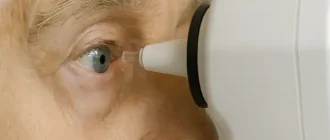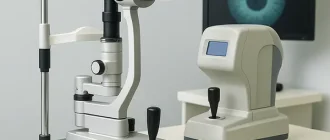“Why Does My Vision Blur When I Switch from Near to Far?”
Imagine this: You’ve just finished reading a book, but when you look up to see what’s happening on TV, everything appears blurry. After a few seconds, your vision clears up, but it’s slow, and you wonder why this is happening. If this sounds familiar, you may be experiencing a common age-related vision issue—difficulty adjusting focus between near and far objects.
This change can affect many aspects of daily life, but understanding the cause and ways to manage it can make a world of difference.
What Causes Difficulty with Focusing Between Distances?

As we age, our eyes naturally lose some of their flexibility. The lens in the eye, which helps focus light, becomes less elastic over time. This condition, known as presbyopia, typically begins to affect people in their 40s and continues to progress as they get older.
When the lens becomes less flexible, it struggles to adjust quickly between focusing on nearby objects and those further away. This can make tasks like reading a book and then glancing up to watch a loved one walk into the room challenging.
Common Situations Where You Might Notice This
1. Reading a Menu in a Restaurant:
You’re reading the fine print of a menu and when you look up to speak to the waiter, their face appears blurry for a few seconds. This delay in refocusing is frustrating and can feel disorienting.
2. Driving:
While driving, you might need to switch focus between the dashboard and the road ahead. The delay in focus adjustment can be unsettling, especially in fast-paced environments.
3. Watching TV:
If you’ve been looking down at your phone and then glance up at the television, you might find the screen blurry for a few moments. This delay, though brief, can interrupt the enjoyment of your favorite show.
How Does it Feel?
It’s not just about vision—it’s also about how it makes you feel. Some people describe it as disorienting, and in situations like driving, it can cause mild anxiety. This minor delay can also make everyday activities seem more exhausting. While the vision does eventually adjust, it’s that brief moment of uncertainty that can be bothersome.
Many people express frustration, saying, “Why can’t my eyes just work like they used to?” But rest assured, this is a normal part of aging, and there are ways to manage it effectively.
Tips for Managing Focus Issues
Thankfully, there are several strategies to manage this problem and keep your daily life running smoothly.
| Tip | How It Helps |
|---|---|
| Get Bifocals or Progressives | These lenses help your eyes focus on both near and far objects, reducing strain. |
| Take Breaks | Regularly rest your eyes by looking at something far away to relax your focus. |
| Ensure Good Lighting | Brighter light can reduce the strain on your eyes when switching focus. |
| Eye Exercises | Simple exercises, like shifting focus from near to far objects, can improve flexibility. |
| Speak to Your Eye Doctor | Your doctor may recommend specialized glasses or contacts that help with presbyopia. |
Case Study: Mrs. Jenkins and Her Garden
Mrs. Jenkins, a 68-year-old retiree, loves spending time in her garden. But lately, she’s noticed that after planting flowers up close, it takes her a while to adjust her vision when looking at the trees or her grandchildren playing in the yard. This delay made her feel disconnected from the activities around her. After speaking with her eye doctor, she received progressive lenses and now finds it much easier to switch focus between the close-up plants and the far-off scenery. “It’s made gardening enjoyable again,” she says.
Exercises for Your Eyes
Just like your body, your eyes can benefit from regular exercise. Try this simple technique to improve focus flexibility:
- Hold your thumb about 10 inches away from your face.
- Focus on your thumb for 15 seconds.
- Now shift your focus to an object about 20 feet away.
- Hold the distant focus for another 15 seconds.
- Repeat this 10 times.
This practice strengthens your eyes’ ability to adjust between distances, and with time, you may notice quicker transitions.
When to See an Eye Doctor
While difficulty adjusting focus between near and far objects is often just a part of aging, it’s important to see an eye doctor if:
- The issue becomes severe and affects your ability to drive or work.
- You experience sudden changes in vision.
- The blurriness lasts longer than a few seconds or comes with headaches.
Your eye doctor can offer solutions like prescription lenses or lifestyle adjustments to help you manage this common issue.
Conclusion: Embracing the Change
Difficulty focusing between near and far objects doesn’t have to interfere with your quality of life. With the right tools and strategies, you can continue to enjoy reading, driving, gardening, and spending time with loved ones without feeling hindered by your vision. Remember, it’s normal, and you’re not alone in this experience.
With proper care and attention, clearer vision is within reach, no matter your age.





